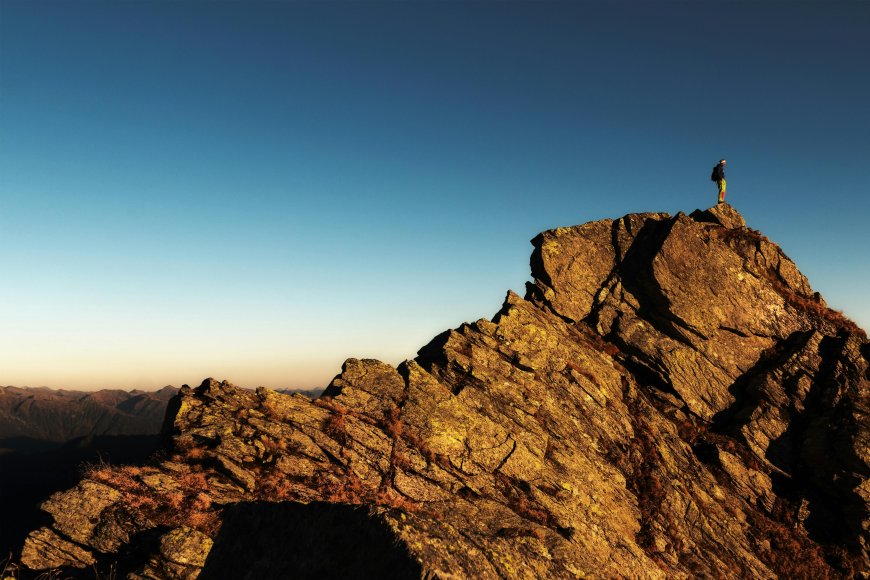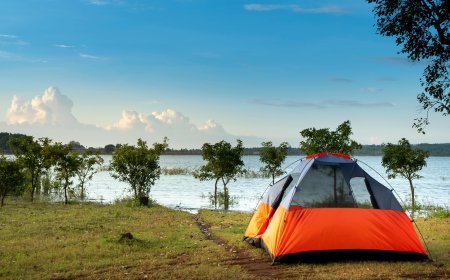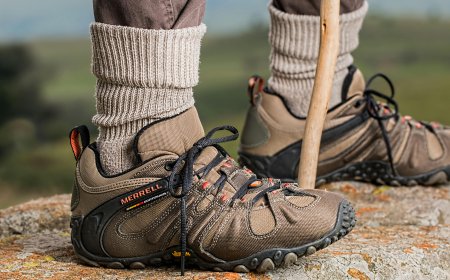The basic guidelines for rock climbing
Enjoy rock climbing safely and confidently with the basic guidelines for beginners, where you'll be taught how to use the proper equipment and basic climbing techniques. Discover the beauty of nature and challenge yourself safely and professionally in the hobby of rock climbing.

Enjoy rock climbing safely and confidently with the basic guidelines for beginners, where you'll be taught how to use the proper equipment and basic climbing techniques. Discover the beauty of nature and challenge yourself safely and professionally in the hobby of rock climbing.
The basic guidelines for rock climbing
Preparing for rock climbing safely requires following important steps and providing necessary care to ensure your safety during the adventure. Here are the detailed steps
1. Familiarize yourself with the proper equipment: Before embarking on any rock climbing trip, ensure you have the proper and complete equipment. This includes a harness, ropes, helmet, and climbing shoes. Regularly inspect your equipment to ensure its safety.
2. Evaluate the route and weather conditions: Before starting the climb, carefully assess the chosen route. Look for routes suitable for your experience level and skills. Also, check the expected weather conditions and the risk of rain, snow, or strong winds.
3. Train in basic techniques: Learn and master basic rock climbing techniques such as anchoring, belaying, and proper rope usage. Practice well before the actual adventure.
4. Form a reliable team: Do not climb alone if you are a beginner. Find a trusted partner or team to accompany you, providing support and assistance when needed.
5. Plan for safety and emergencies: Develop a safety and emergency plan before starting the climb, ensuring there is a plan to deal with emergencies such as injuries or loss of communication.
6. Maintain communication with the ground: Don't forget to notify a trusted person about your route and expected return time. Use your mobile phone or other communication devices to stay in touch if necessary.
7. Check your physical fitness level: Make sure you have an adequate level of physical fitness to support rock climbing, and if not, improve it before the adventure.
By following these steps and preparing carefully, you can enjoy rock climbing safely and confidently.
Techniques and equipment for achieving success
Techniques and equipment for rock climbing are an essential part of ensuring success and safety during this thrilling experience. Here are detailed descriptions of some of these techniques and equipment
1. Rope and harness use
- Ropes: Used for ascending and descending safely. Ropes should be sturdy and resistant to wear.
- Harness: Secured around the waist and thighs to provide support and safety during climbing. It is used to tie into ropes and assist in weight distribution.
2. Climbing shoes
- Shoes: Climbing shoes feature a rubber sole that provides strong grip on rocks and good support for the feet. They should be comfortable and fit your foot size properly.
3. Anchoring and belaying techniques
- Anchoring: Involves using your feet and hands to find points of strength in the rocks and using them to maintain balance and progress.
- Belaying: Belaying is used to overcome obstacles and move between different points on the rocks using ropes and special loops.
4. Protective helmet use
- Helmet: Used to protect the head from falling rocks and other solid objects. It should be sturdy and fit your head size properly to provide sufficient protection.
5. Rescue and emergency equipment
- Belay device: Used in case of a fall to provide an opportunity to stop and secure on the rope.
- Emergency first aid kit: Contains materials for first aid to deal with minor injuries or emergencies.
6. Training in techniques and mental preparedness
- Training: Before the actual adventure, train in using the equipment and applying basic rock climbing techniques.
- Mental preparedness: Ensure you are aware of potential challenges and capable of dealing with them calmly and effectively.
By using these techniques and equipment correctly, you will be able to achieve success in rock climbing safely and enjoyably.
Important guidelines for rock climbers
Important guidelines for rock climbers are an essential part of ensuring their safety and achieving success in this thrilling and risky sport. Here are some detailed guidelines
1. Evaluate the situation and the route
- Before starting the climb, carefully evaluate the rocks and the chosen route. Look for routes suitable for your experience level and skills.
- Check the condition of the rocks and avoid climbing in wet, snowy, or adverse weather conditions.
2. Use the proper equipment
- Ensure the use of proper equipment and regularly inspect it to ensure your safety. This includes ropes, harness, helmet, and climbing shoes.
- Learn how to use each piece of this equipment properly according to approved techniques.
3. Maintain personal safety
- Ensure you are well-conditioned for rock climbing. You should have an appropriate level of physical fitness and good flexibility.
- Take care to maintain your personal safety and avoid unnecessary risks.
4. Communicate with peers and report
- Do not climb alone. You should always have a partner or team for assistance and support.
- Notify a trusted person about your route, location, and expected return time, and make sure to contact them upon safely returning.
5. Training and learning basic techniques
- Train in basic rock climbing techniques before the actual adventure.
- Learn how to use anchoring, belaying, and safety techniques during climbing.
6. Prepare for emergencies
- Prepare an emergency plan that includes how to deal with injuries, technical problems, or adverse weather conditions.
- Carry an emergency first aid kit and contact emergency services if necessary.
By carefully following and implementing these guidelines correctly, you can enjoy rock climbing safely and confidently.
How to rock climb safely and professionally
Climbing rocks safely and professionally requires adhering to specific procedures and following certain techniques to ensure your safety and the success of your experience. Here is a detailed explanation of how to climb rocks safely and professionally
1. Assessment and planning
- Before starting the climb, evaluate the chosen rocks and determine the appropriate route.
- Study the map and identify routes, stopping points, and escape routes.
2. Use of proper equipment
- Ensure the use of proper equipment and regularly inspect it to ensure its safety.
- Use ropes, harnesses, helmets, and climbing shoes correctly according to manufacturer guidelines.
3. Basic climbing techniques
- Learn basic climbing techniques such as anchoring, belaying, and using ropes correctly.
- Maintain your balance and use muscle strength effectively to control your movements.
4. Communication and coordination with the team
- Do not climb rocks alone. Work with a trusted team and communicate with them continuously during the climb.
- Define each team member's role and how to communicate in emergencies or when assistance is needed.
5. Personal safety
- Take care to maintain your personal safety and avoid unnecessary risks.
- Wear comfortable and suitable climbing attire and ensure you have an adequate supply of water and food.
6. Evaluation of weather conditions
- Before starting the climb, check the expected weather conditions.
- Avoid climbing in rain, snow, or strong winds that could increase the risks of climbing.
7. Emergency preparedness
- Carry an emergency first aid kit with you and contact emergency services if needed.
- Be prepared to deal with minor injuries or emergencies that may occur during the climb.
By following these guidelines and instructions, you can climb rocks safely and professionally and enjoy an exciting and challenging experience.
Simple steps to confidently embrace challenges
Achieving confidence in facing challenges during rock climbing requires following simple yet effective steps. Here are detailed steps to achieve that
1. Setting goals and aspirations
- Before starting the climb, identify the goals you want to achieve and determine the level of challenge you want to face.
- Be realistic in setting goals and plan to achieve them gradually and systematically.
2. Training and physical preparation
- Regularly train your body and improve your physical fitness through appropriate exercises such as running and muscle strengthening.
- Ensure to train in basic climbing techniques and continuously develop your skills.
3. Route planning and mental readiness
- Carefully study the chosen route and identify critical and challenging points along the way.
- Reassess your abilities and determine the appropriate strategy to deal with those points.
4. Using psychological techniques
- Rely on meditation and positive affirmations techniques to improve your focus and increase your self-confidence before climbing.
- Speak to yourself positively and use self-encouragement to overcome challenges and fears you may face.
5. Starting with confidence and self-motivation
- Start climbing with confidence and visualize success and the challenge you are overcoming.
- Motivate yourself by thinking about past achievements and your ability to overcome challenges.
6. Focusing on safety and enjoyment
- During the climb, prioritize safety and ensure proper use of equipment and adherence to correct techniques.
- Enjoy the challenge and excitement that climbing offers and do not let fears hinder your experience.
By following these simple steps, you will be able to achieve challenges confidently and enjoy the climbing experience with maximum enthusiasm and safety.
Rock climbing experience
Rock climbing experience is a unique and thrilling adventure that combines challenge, adventure, and close connection with nature. Here is a detailed explanation of how to experience rock climbing
1. Preparation and Planning
- Your rock climbing experience begins with early preparation, including gathering necessary equipment such as ropes, harness, and helmet.
- Evaluate the chosen climbing location and determine the appropriate route suitable for your experience level and skills.
2. Immersion in Nature
- Upon reaching the climbing site, immerse yourself in the beauty of the surrounding nature and enjoy the breathtaking landscapes and fresh air.
- Listen to the natural sounds and feel the tranquility and serenity surrounding you.
3. Starting the Climb
- Set up the equipment and prepare to ascend, starting with overcoming the initial challenges and progressing slowly and steadily with focus.
- Use proper climbing techniques such as anchoring, traversing, and using ropes correctly.
4. Climbing Challenges
- During the climb, you will encounter various challenges such as difficult rock formations and steep inclines.
- Challenge yourself to overcome these obstacles and utilize your skills and muscle strength to conquer them.
5. Feeling of Achievement and Satisfaction
- Upon reaching the summit or successfully completing the designated route, you will feel a sense of accomplishment and satisfaction.
- Enjoy the magnificent views from the top and revel in your ascent and the surrounding environment.
6. Safely Returning
- After completing the rock climb, ensure a safe descent using proper rappelling techniques.
- Check the equipment and make sure not to leave anything behind, maintaining cleanliness at the site.
Rock climbing experience provides you with the opportunity for challenge and overcoming obstacles, along with enjoying the natural beauty and close connection with nature.
Exploring heights
Exploring heights is an exhilarating part of the rock climbing experience, allowing adventurers to explore different natural areas and reach breathtaking heights. Here is a detailed explanation of how to explore heights
1. Exploring Natural Areas
- Exploration of heights begins with finding suitable natural areas for climbing, such as mountains, cliffs, and rugged rocks.
- Explore local sites and find places that offer exciting climbing challenges and stunning natural scenery.
2. Preparation and Planning
- Once you've chosen the right location, prepare for your trip by equipping yourself with necessary climbing gear like ropes, harnesses, and helmets.
- Study maps, identify potential climbing routes, and pinpoint prominent features and difficult terrains.
3. Starting the Climb
- Begin climbing cautiously and attentively, focusing on using proper climbing techniques such as footholding, traversing, and correctly using ropes.
- Challenge yourself to overcome obstacles and difficulties you may encounter while ascending.
4. Enjoying the Views and Adventure
- As you ascend, enjoy the breathtaking views of the surrounding landscapes and the sense of freedom and strength.
- Embrace the challenge, adventure, and the sense of accomplishment upon reaching the summit or desired height.
5. Returning Safely
- After exploring heights and enjoying the adventure, ensure a safe descent using proper techniques for rappelling.
- Check your equipment and make sure not to leave anything behind, leaving the site as you found it.
Exploring heights during rock climbing provides a unique and thrilling opportunity to explore nature, achieve new accomplishments, and discover entirely new areas.
Summary
The basic guidelines for rock climbing include using the right equipment, carefully assessing situations, and training in fundamental climbing techniques. It's also essential to communicate with a trusted team and adhere to personal safety procedures. Avoid climbing in adverse weather conditions and prepare an emergency plan. By following these guidelines, climbers can enjoy a safe and confident climbing experience.
Sources
1. REI (Recreational Equipment, Inc.) Website
- REI offers articles and tips on the basics, techniques, and necessary equipment for rock climbing.
2. Climbing Magazine Website
- It contains articles and guides for beginners on how to start rock climbing and basic techniques.
3. Rock and Ice Magazine Website
- Provides articles and lessons on climbing techniques, safety, and training.
4. American Alpine Institute (AAI) Website
- Offers articles and educational resources on rock climbing, training, and preparation.
What's Your Reaction?








































































































































































